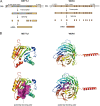The potential role of N7-methylguanosine (m7G) in cancer
- PMID: 35590385
- PMCID: PMC9118743
- DOI: 10.1186/s13045-022-01285-5
The potential role of N7-methylguanosine (m7G) in cancer
Abstract
N7-methylguanosine (m7G), one of the most prevalent RNA modifications, has recently attracted significant attention. The m7G modification actively participates in biological and pathological functions by affecting the metabolism of various RNA molecules, including messenger RNA, ribosomal RNA, microRNA, and transfer RNA. Increasing evidence indicates a critical role for m7G in human disease development, especially cancer, and aberrant m7G levels are closely associated with tumorigenesis and progression via regulation of the expression of multiple oncogenes and tumor suppressor genes. Currently, the underlying molecular mechanisms of m7G modification in cancer are not comprehensively understood. Here, we review the current knowledge regarding the potential function of m7G modifications in cancer and discuss future m7G-related diagnostic and therapeutic strategies.
Keywords: Cancer; N 7-methylguanosine (m7G); RNA metabolism; RNA modification.
© 2022. The Author(s).
Conflict of interest statement
The authors declare that they have no competing interests.
Figures




Similar articles
-
Exploring the role of m7G modification in Cancer: Mechanisms, regulatory proteins, and biomarker potential.Cell Signal. 2024 Sep;121:111288. doi: 10.1016/j.cellsig.2024.111288. Epub 2024 Jul 5. Cell Signal. 2024. PMID: 38971569 Review.
-
M7G-related tumor immunity: novel insights of RNA modification and potential therapeutic targets.Int J Biol Sci. 2024 Jan 27;20(4):1238-1255. doi: 10.7150/ijbs.90382. eCollection 2024. Int J Biol Sci. 2024. PMID: 38385078 Free PMC article. Review.
-
m7G-DPP: Identifying N7-methylguanosine sites based on dinucleotide physicochemical properties of RNA.Biophys Chem. 2021 Dec;279:106697. doi: 10.1016/j.bpc.2021.106697. Epub 2021 Oct 5. Biophys Chem. 2021. PMID: 34628276
-
BERT-m7G: A Transformer Architecture Based on BERT and Stacking Ensemble to Identify RNA N7-Methylguanosine Sites from Sequence Information.Comput Math Methods Med. 2021 Aug 25;2021:7764764. doi: 10.1155/2021/7764764. eCollection 2021. Comput Math Methods Med. 2021. PMID: 34484416 Free PMC article.
-
Iterative feature representation algorithm to improve the predictive performance of N7-methylguanosine sites.Brief Bioinform. 2021 Jul 20;22(4):bbaa278. doi: 10.1093/bib/bbaa278. Brief Bioinform. 2021. PMID: 33169141
Cited by
-
The role of epigenetic methylations in thyroid Cancer.World J Surg Oncol. 2024 Oct 25;22(1):281. doi: 10.1186/s12957-024-03568-2. World J Surg Oncol. 2024. PMID: 39456011 Free PMC article. Review.
-
Liquid-liquid phase separation in diseases.MedComm (2020). 2024 Jul 13;5(7):e640. doi: 10.1002/mco2.640. eCollection 2024 Jul. MedComm (2020). 2024. PMID: 39006762 Free PMC article. Review.
-
The role of RNA modification in urological cancers: mechanisms and clinical potential.Discov Oncol. 2023 Dec 20;14(1):235. doi: 10.1007/s12672-023-00843-8. Discov Oncol. 2023. PMID: 38117350 Free PMC article. Review.
-
A novel defined m7G regulator signature to investigate the association between molecular characterization and clinical significance in lung adenocarcinoma.Front Oncol. 2022 Aug 2;12:897323. doi: 10.3389/fonc.2022.897323. eCollection 2022. Front Oncol. 2022. PMID: 35982949 Free PMC article.
-
Prognostic model and ceRNA network of m7G- and radiosensitivity-related genes in hepatocellular carcinoma.Heliyon. 2024 Apr 24;10(9):e29925. doi: 10.1016/j.heliyon.2024.e29925. eCollection 2024 May 15. Heliyon. 2024. PMID: 38707306 Free PMC article.
References
Publication types
MeSH terms
Substances
Grants and funding
LinkOut - more resources
Full Text Sources

